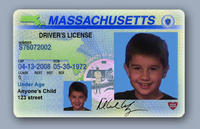-
Federal ID deadline draws near, but some states are not yet ready
A federal deadline imposing security standards for states-issued driver’s licenses is drawing near, but according to New Mexico’s congressional delegation, an extension is possible for the state for complying with the law; the act currently has thirty-one requirements, but New Mexico has not met sixteen of them and eight of those are related to the driver’s license law
-
-
Supreme Court to hear police DNA-collection case
The United States Supreme Court last week granted certiorari in Maryland v. King; in the case, Maryland law enforcement stands to lose the right to require a DNA collection as part of booking procedures for certain felony crimes; a similar law was passed by Congress in 2004 for federal arrests, and twenty-four other state legislatures have also passed such laws
-
-
New strategy for fingerprint visualization
Identifying fingerprints on paper is a commonly used method in police forensic work, but it is not easy to make those fingerprints visible. Now, scientists have developed a new approach for making such fingerprints more readily readable
-
-
Face-recognition e-Gate at Amsterdam airport moving passengers at rapid pace
E-Gate, the automated border control system developed by Accenture and Vision-Box for the Netherlands Ministry of Internal Affairs, is on target to process its one-millionth passenger at Schiphol Airport in December
-
-
Aussie banks considering biometric security
Australia’s major banks are considering a move to biometric security systems in an effort to boost security for their customers; the banks are changing their systems as a way for customers to keep their money and valuables safe without ATM cards
-
-
Biometric technologies adopted by more Australian banks

The use of face-recognition biometrics technology will soon become main stream in Australian banks, and may even be used in conjunction with other technologies; in a survey, 79 percent of Australians said that they were comfortable with fingerprint technology replacing banking PINs
-
-
Law enforcement can store, identify millions of voice samples using new software

Everyone this day can be identified by a fingerprint, DNA, or even a picture. Now, with the help of a Russian company, the FBI will soon be using voice recognition to identify people; the FBI says voice biometrics will be a “reliable and consistent means of identification for use in remote recognition”
-
-
GAO: Easily obtained counterfeit IDs present real risks

The Government Accountability Office (GAO) released a report in which the agency demonstrates that counterfeit documents can still be used easily to obtain valid driver’s licenses and state-issued identification cards under fictitious identities; GAO recommended that DHS exert more assertive leadership in an effort to correct the problem
-
-
Voice verification technology prevents impersonators from obtaining voiceprints
Computer users have learned to preserve their privacy by safeguarding passwords, but with the rise of voice authentication systems, they also need to protect unique voice characteristics; researchers say this is possible with a system they developed which converts a user’s voiceprint into something akin to passwords
-
-
"Cognitive fingerprints" for bolstering computer passwords
It will not make passwords passé, but researchers intends to use “cognitive fingerprints” to make sure you are you, and not an imposter; a novel software-based authentication tool called covert-conditioned biometrics will attempt to use a unique sequence of problem-solving moves to distinguish between a legitimate user and an identity thief
-
-
Border Patrol kiosk detects liars trying to enter U.S.

The U.S. Customs and Border Protection (CBP) is using border crossing stations in Arizona to test new technology to detect liars as they attempt to enter the country; travelers are subjected to a 5-minute interview with the kiosk, while microphones monitor vocal pitch frequency and quality, an infrared camera monitors eye movement and pupil dilation, and a high definition camera monitors facial expression
-
-
New biometrics discipline -- foot biometrics – for security, disease detection
Identity science takes a giant, well, step forward with a new discipline in biometrics: foot biometrics; researchers at the new $1.5 million per year Pedo-Biometrics Research and Identity Automation Lab will test insole sensory system prototypes for a variety of identification uses, from security to detecting the onset of such diseases as diabetes and Parkinson’s
-
-
Francisco Partners acquires biometrics provider Cross Match Technologies
Francisco Partners, a technology-focused private equity firm, has acquired Cross Match Technologies, Inc., a provider of interoperable biometric identity management systems, applications, and services
-
-
New research raises questions about iris recognition systems
Since the early days of iris recognition technologies, it has been assumed that the iris was a “stable” biometric over a person’s lifetime — “one enrollment for life”; researchers find, however, that iris biometric enrollment is susceptible to an aging process that causes recognition performance to degrade slowly over time
-
-
NIST releases second draft of PIV cards security standard for comment
The National Institute of Standards and Technology (NIST) has released the second-round draft version of its updated security standard for identity credentials in the Personal Identity Verification cards (PIV cards) that all federal employees and contractors must use; NIST is requesting comments from the public on the document, which is intended to be the last draft before the final version is published
-
- All
- Regional
- Water
- Biometrics
- Borders/Immig
- Business
- Cybersecurity
- Detection
- Disasters
- Government
- Infrastructure
- International
- Public health
- Public Safety
- Communication interoperabillity
- Emergency services
- Emergency medical services
- Fire
- First response
- IEDs
- Law Enforcement
- Law Enforcement Technology
- Military technology
- Nonlethal weapons
- Nuclear weapons
- Personal protection equipment
- Police
- Notification /alert systems
- Situational awareness
- Weapons systems
- Sci-Tech
- Sector Reports
- Surveillance
- Transportation
Advertising & Marketing: advertise@newswirepubs.com
Editorial: editor@newswirepubs.com
General: info@newswirepubs.com
2010-2011 © News Wire Publications, LLC News Wire Publications, LLC
220 Old Country Road | Suite 200 | Mineola | New York | 11501
Permissions and Policies
Editorial: editor@newswirepubs.com
General: info@newswirepubs.com
2010-2011 © News Wire Publications, LLC News Wire Publications, LLC
220 Old Country Road | Suite 200 | Mineola | New York | 11501
Permissions and Policies
